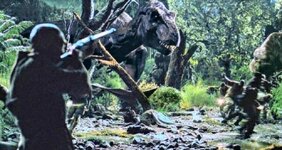Wow - that’s a great experience with two buffalo.
One interesting bison kill video in Colorado from 12,000 years ago was 48 animals. The cool thing about it was how they could document fairly precisely where individual tools were made, resharpened and discarded when broken or worn to a nub. So many tools were needed, they surmised before the hunt a group traveled many miles away to known high quality rock sources and carried back essentially many backpacks full of semi processed tool blanks. After the butchering was done they just left a bunch of the worn or marginal tools. The logistics are impressive since they carried everything, or at most had dogs to help carry stuff.
It’s a good thing I didn’t know anything about archeology as a teenager - I would have found digging up old hunting camps to be really interesting - too interesting. There’s a Wyoming professor who traveled to Africa to stab an elephant with a spear to see how tough it was, and wrote a lot of archeology papers about ice age hunting tactics based on experiments he’s done while actually hunting. 18 yr old me would love that kind of college program.


